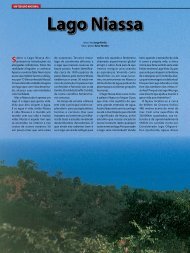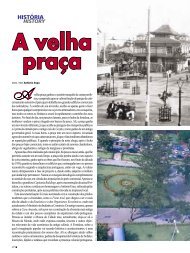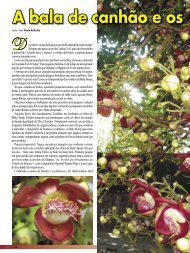Os leões que protegem um novo edifício chinês, na baixa de ... - LAM
Os leões que protegem um novo edifício chinês, na baixa de ... - LAM
Os leões que protegem um novo edifício chinês, na baixa de ... - LAM
You also want an ePaper? Increase the reach of your titles
YUMPU automatically turns print PDFs into web optimized ePapers that Google loves.
Kuan Ti, o protec<br />
texto / text Paola Rolletta<br />
fotos / photos Artur Ferreira<br />
O s <strong>leões</strong> <strong>que</strong> <strong>protegem</strong> <strong>um</strong> <strong>novo</strong> <strong>edifício</strong> <strong>chinês</strong>, <strong>na</strong> <strong>baixa</strong> <strong>de</strong><br />
Maputo, provocaram alg<strong>um</strong>a polémica sobre a paisagem<br />
urba<strong>na</strong> da cida<strong>de</strong> quando ali foram colocados. São parte <strong>de</strong> <strong>um</strong>a nova<br />
aventura chinesa no país. Uma aventura <strong>que</strong> é marcada pelo <strong>novo</strong> r<strong>um</strong>o da<br />
história do mundo, <strong>de</strong>bate i<strong>na</strong>cabado em torno dos dias <strong>que</strong> hão-<strong>de</strong> vir. Há<br />
outro protector, <strong>de</strong> cara vermelha e barba preta, n<strong>um</strong> trono entalhado, dourado<br />
e preto, <strong>que</strong> dá as boas-vindas e protege contra a malda<strong>de</strong>. Ficou <strong>de</strong>sprotegido<br />
no <strong>de</strong>senrolar da História. E tem <strong>um</strong>a longa história própria para contar.<br />
A aventura dos chineses em Moçambi<strong>que</strong> tem várias etapas. Uma, remonta<br />
ao fi m do século XIX, quando alg<strong>um</strong>as famílias, vindas sobretudo<br />
da região <strong>de</strong> Cantão, fi xaram residência em Lourenço Mar<strong>que</strong>s. Muitos<br />
<strong>de</strong>les iam a caminho da Montanha Dourada, o nome dado a São Francisco,<br />
on<strong>de</strong> foi encontrado ouro, pela primeira vez em 1848. Mas, para confusão<br />
geral, <strong>que</strong>r Melbourne, <strong>na</strong> Austrália, <strong>que</strong>r Joanesburgo, <strong>na</strong> África do Sul,<br />
eram chamadas Nova Montanha Dourada. A história conta <strong>que</strong> só quando<br />
chegavam a Joanesburgo é <strong>que</strong> muitos dos chineses <strong>de</strong>scobriam <strong>que</strong> não<br />
estavam em São Francisco! E muitos outros nem lá chegavam por<strong>que</strong><br />
<strong>de</strong>cidiam fi car por cá.<br />
44<br />
Kuan Ti<br />
Outros vieram das Ilhas Maurícias, on<strong>de</strong> não podiam possuir a terra,<br />
pelo <strong>que</strong> <strong>de</strong>cidiam embarcar para novas oportunida<strong>de</strong>s. Famosas eram as<br />
machambas dos chineses <strong>na</strong> Manhiça, com gran<strong>de</strong>s ba<strong>na</strong><strong>na</strong>is e hortaliças<br />
<strong>que</strong> abasteciam o mercado da capital.<br />
Um dos chineses mais famosos foi Ja Assam, <strong>um</strong> carpinteiro <strong>que</strong> fez<br />
fortu<strong>na</strong> em Lourenço Mar<strong>que</strong>s. Tornou-se dono do prédio <strong>que</strong> ganhou o seu<br />
nome, com frente para o Bazar, fazendo curva <strong>na</strong> esqui<strong>na</strong> da actual 25 <strong>de</strong><br />
Setembro com a Karl Marx. Antes era ali o LM Bazar, hoje se<strong>de</strong> do Centro<br />
Cultural Brasileiro, e ia até ao Marta da Cruz, outra loja gran<strong>de</strong>, mesmo frente<br />
ao Banco <strong>de</strong> Moçambi<strong>que</strong> (<strong>na</strong> altura BNU).<br />
Um dos outros prédios chineses ainda existentes é o Tchi Kung Tong, <strong>na</strong><br />
avenida Josi<strong>na</strong> Machel, on<strong>de</strong> se jogava o mah jong. Era <strong>um</strong> dos círculos<br />
recreativos da comunida<strong>de</strong>, <strong>um</strong> belo <strong>edifício</strong> <strong>que</strong> mereceria outra atenção.<br />
A comunida<strong>de</strong> chinesa <strong>de</strong> Lourenço Mar<strong>que</strong>s chegou a contar cerca <strong>de</strong><br />
3.500 pessoas, e a da Beira cerca <strong>de</strong> 4.000 pessoas. Eram sobretudo carpinteiros,<br />
pedreiros e agricultores, incluindo donos <strong>de</strong> restaurantes on<strong>de</strong> a comida<br />
era boa e barata. Não encontramos muita literatura sobre a sua presença no<br />
início do século XX em Moçambi<strong>que</strong>.
tor <strong>de</strong>sprotegido<br />
Um dos textos <strong>que</strong> circula, invariavelmente reproduzido, é Monhés,<br />
Baneanes, Chi<strong>na</strong>s e Afro-maometanos - Colonialismo e racismo em Lourenço<br />
Mar<strong>que</strong>s, Moçambi<strong>que</strong>, 1890-1940 (Lusotopie, 2000) <strong>de</strong> Val<strong>de</strong>mir<br />
Zamparoni. O historiador brasileiro escreve: “<strong>Os</strong> chineses, embora poucos,<br />
reuniam-se no Club Fiel Observante do Direito (Chee Kung Tong), no Club<br />
Chinês <strong>de</strong> Lourenço Mar<strong>que</strong>s e, até mesmo, mantinham <strong>um</strong>a representação<br />
do Partido Nacio<strong>na</strong>lista Chinês, o Kuo Min Tang. O Pago<strong>de</strong> Chinês (Associação<br />
Chinesa), foi fundado em 1903, mas reconhecido ofi cialmente pelo<br />
governo colonial somente em 1924, em terreno doado por Ja Assam, <strong>um</strong><br />
imigrante pioneiro. O Pago<strong>de</strong> foi <strong>um</strong>a das mais activas associações e tinha<br />
como objectivos promover o bem-estar da comunida<strong>de</strong> através da educação,<br />
da organização <strong>de</strong> festas, bailes e jogos e da assistência social aos membros<br />
necessitados em caso <strong>de</strong> <strong>de</strong>semprego, doença, invali<strong>de</strong>z e morte. Para os<br />
seus cultos, a comunida<strong>de</strong> fez construir, em 1903, junto com o Pago<strong>de</strong>, <strong>um</strong><br />
templo <strong>de</strong>dicado a Buda (sic). Era <strong>um</strong> <strong>edifício</strong> quadrangular <strong>de</strong> ma<strong>de</strong>ira e<br />
zinco e sem características arquitectónicas chinesas...” Não se tratava <strong>de</strong><br />
Buda, mas sim <strong>de</strong> <strong>um</strong>a outra <strong>de</strong>ida<strong>de</strong>. Era Kuan Ti.<br />
Kuan Ti é <strong>um</strong>a das divinda<strong>de</strong>s chinesas mais po<strong>de</strong>rosas e veneradas ainda<br />
Antigo Pago<strong>de</strong> Chinês<br />
Old Chinese Pagoda<br />
hoje. Foi <strong>um</strong> gran<strong>de</strong> guerreiro, com existência real, tendo <strong>na</strong>scido <strong>na</strong> Chi<strong>na</strong><br />
em 162 d.C., no fi <strong>na</strong>l da di<strong>na</strong>stia Han, e foi <strong>de</strong>golado aos 58 anos. A sua vida<br />
é <strong>um</strong> dos clássicos da literatura chinesa, O Romance dos Três Reinos.<br />
A aura mítica <strong>que</strong> envolve Kuan Ti é a mesma <strong>de</strong> Tchaka Zulu ou dos<br />
cavaleiros europeus da Ida<strong>de</strong> Média ou do herói inglês Robin Hood (Robin<br />
dos Bos<strong>que</strong>s). E assim se entrelaçou a história <strong>de</strong> Kuan Ti com a História<br />
<strong>de</strong> Moçambi<strong>que</strong>. E não é nenh<strong>um</strong>a heresia.<br />
A gran<strong>de</strong> estátua do guerreiro, <strong>de</strong>us da guerra e protector das artes<br />
marciais, permanece <strong>de</strong>s<strong>de</strong> as <strong>na</strong>cio<strong>na</strong>lizações (1975) <strong>na</strong> cave do Museu <strong>de</strong><br />
Arte, em Maputo. Estava no altar da Escola Chinesa, actual se<strong>de</strong> do Instituto<br />
Nacio<strong>na</strong>l <strong>de</strong> Artes Visuais. Escapou à apropriação <strong>de</strong>scontrolada das mobílias,<br />
por exemplo, <strong>que</strong> <strong>de</strong>coravam as salas.<br />
O altar foi “ofi cialmente” entregue à Associação da Comunida<strong>de</strong> Chinesa<br />
em Moçambi<strong>que</strong>, mas <strong>na</strong> realida<strong>de</strong> isso ainda não se concretizou,<br />
pois a Associação ainda não tomou posse da sua se<strong>de</strong> antiga como lhe<br />
fora prometido em 2005 n<strong>um</strong>a cerimónia ofi cial.<br />
Kuan Ti foi criado pela mãe. Quando era jovem, e para <strong>de</strong>fen<strong>de</strong>r os seus<br />
concidadãos mais fracos, matou <strong>um</strong> homem maldoso e muito po<strong>de</strong>roso.<br />
Índico 45
Kuan Ti, the Unguar<strong>de</strong>d Guardian<br />
he placing of the lions that guard the new Chinese building in down-<br />
T town Maputo caused some controversy with regard to the city’s urban<br />
landscape. They are part of a new Chinese presence in the country, a presence<br />
that is <strong>de</strong>termined by a new course in world history, an unfinished <strong>de</strong>bate<br />
about the days to come. There is another guardian, with a red face and a black<br />
beard, on an engraved throne of gold and black, who welcomes and protects<br />
against evil. He remained unguar<strong>de</strong>d in the unfolding of history and has his<br />
own long story to tell.<br />
The Chinese presence in Mozambi<strong>que</strong> occurred in several stages. The first<br />
traces back to the end of the 19th century with the arrival of a few families from<br />
the Canton region who settled in Lourenço Mar<strong>que</strong>s. Many of them followed<br />
the trail of the Gold Mountain, the <strong>na</strong>me given to San Francisco where gold<br />
was discovered for the first time in 1848. However, due to a general confusion,<br />
both Melbourne in Australia and Johannesburg in South Africa were known<br />
as the New Gold Mountain. History tells us that it was only when they arrived<br />
in Johannesburg that many Chinese discovered that they had not come to San<br />
Francisco. And many others did not even get there because they had <strong>de</strong>ci<strong>de</strong>d<br />
to stay.<br />
Many came from Mauritius, where they were not allowed to possess land<br />
and thus <strong>de</strong>ci<strong>de</strong>d to embark on a journey seeking new opportunities. The<br />
Chinese machambas in Manhiça were famous, with their big ba<strong>na</strong><strong>na</strong> plantations<br />
and vegetables that supplied the market in the capital.<br />
One of the most famous Chinese was Ja Assam, a carpenter who ma<strong>de</strong> a<br />
fortune in Lourenço Mar<strong>que</strong>s. He became the owner of a building that bore<br />
his <strong>na</strong>me, facing the Bazaar, forming a curve on the corner of the present-day<br />
25 <strong>de</strong> Setembro and Karl Marx streets. This was previously the spot of the<br />
46<br />
LM Bazaar (today it is the seat of the Brazilian Cultural Centre) and stretched<br />
out to Marta da Cruz, another big shop, facing the Banco <strong>de</strong> Moçambi<strong>que</strong><br />
(BNU at the time).<br />
Another Chinese building that still stands today is the Tchi Kung Tong, on<br />
the Josi<strong>na</strong> Machel Avenue, where mah jong was played. It was one of the<br />
recreatio<strong>na</strong>l centres of the community, a beautiful edifice that <strong>de</strong>serves better<br />
care.<br />
The Chinese community n<strong>um</strong>bered around 3500 people in Lourenço<br />
Mar<strong>que</strong>s and around 4000 in Beira. They were mostly carpenters, stonemasons<br />
and farmers, as well as owners of restaurants that served good and cheap food.<br />
Their presence in Mozambi<strong>que</strong> at the beginning of the 20 th century is scarcely<br />
recor<strong>de</strong>d in literature.<br />
One of the available faithfully reproduced texts is Val<strong>de</strong>mir Zamparoni’s<br />
Monhés, Baneanes, Chi<strong>na</strong>s e Afro-maometanos - Colonialismo e Racismo em<br />
Lourenço Mar<strong>que</strong>s, Moçambi<strong>que</strong>, 1890-1940 (Lusotopie, 2000). The Brazilian<br />
historian writes: “The Chinese, although few in n<strong>um</strong>ber, meet in the Faithful<br />
Observer of the Law Club (Chee Kung Tong), the Chinese club in Lourenço<br />
Mar<strong>que</strong>s and even had a representative of the Chinese Natio<strong>na</strong>list Party<br />
(Kuo Min Tang). The Chinese Pagoda (a Chinese association) was foun<strong>de</strong>d in<br />
1903, but only officially recognised by the colonial government in 1924, on a<br />
property do<strong>na</strong>ted by Ja Assam, a pioneer immigrant. The Pagoda was one of<br />
the most active associations and had as its aims the fostering of the well-being<br />
of the community through education, organising festive events, dances and<br />
games and social assistance to needy members in the case of unemployment,<br />
illness, disability and <strong>de</strong>ath. For its religious practices, along with the Pagoda<br />
the community built a temple <strong>de</strong>dicated to the Buddha in 1903 (sic). It was
Por isso foi obrigado a fugir da sua al<strong>de</strong>ia. Para viver, ia vagueando e aceitando<br />
trabalhos h<strong>um</strong>il<strong>de</strong>s. Um dia, n<strong>um</strong>a tasca, encontrou dois jovens, Liu<br />
Pei e Chang Fei, <strong>que</strong>, como ele, não tinham abrigo nem emprego. A lenda<br />
conta <strong>que</strong>, <strong>na</strong><strong>que</strong>le mesmo dia, n<strong>um</strong> pomar <strong>de</strong> pessegueiros em flor, selaram<br />
<strong>um</strong> pacto <strong>de</strong> ter<strong>na</strong> irmanda<strong>de</strong>. Acabariam recrutados pelo governo para<br />
suprimir a revolta dos “turbantes amarelos”. Chefiando <strong>um</strong> grupo <strong>de</strong> 300<br />
homens conseguiram <strong>de</strong>rrotar os rebel<strong>de</strong>s, começando assim a sua cruzada<br />
para juntar o fragmentado império <strong>chinês</strong>. Durante as várias guerras, Kuan<br />
Ti distinguiu-se como <strong>um</strong> Robin Hood, lutando por causas justas contra os<br />
opressores. Tinha <strong>um</strong> génio militar muito apurado e a sua arma, o kwon do,<br />
ficou famosa.<br />
Kuan Ti tornou-se o símbolo <strong>de</strong> lealda<strong>de</strong>, justiça e h<strong>um</strong>ilda<strong>de</strong>. Ao longo<br />
dos tempos foi feito du<strong>que</strong>, príncipe guerreiro e, fi<strong>na</strong>lmente em 1594, o<br />
Imperador Ming Wan Li conferiu-lhe o título <strong>de</strong> Gran<strong>de</strong> Deida<strong>de</strong> Fiel<br />
48<br />
a quadrangular building ma<strong>de</strong> of wood and zinc without any Chinese<br />
architectural characteristics…” It was, in fact, not <strong>de</strong>dicated to the Buddha<br />
but to another <strong>de</strong>ity, Kuan Ti.<br />
Kuan Ti is still today one of the most powerful and worshipped Chinese<br />
<strong>de</strong>ities. He was a great warrior, a historical figure who was born in Chi<strong>na</strong> in<br />
162 AC, at the time of the collapse of the Han Dy<strong>na</strong>sty, and was behea<strong>de</strong>d<br />
at 58 years of age. The story of his life became one of the classic works of<br />
Chinese literature, The Romance of the Three Kingdoms.<br />
The mythical aura created around Kuan Ti may be compared to that of Shaka<br />
Zulu, the medieval European knights or the English hero Robin Hood.<br />
It was thus that the story of Kuan Ti became intertwined with the history of<br />
Mozambi<strong>que</strong>. And it is not a heresy at all.<br />
The large statue of the warrior, god of war and guardian of the martial arts,<br />
stands in the basement of the Art Muse<strong>um</strong> in Maputo since the <strong>na</strong>tio<strong>na</strong>lizations<br />
of 1975. It used to be situated in the altar of the Chinese School, the current seat<br />
of the Natio<strong>na</strong>l Institute of Visual Arts. It eschewed the rampant appropriation<br />
of the furniture that <strong>de</strong>corated the halls.<br />
The altar was “officially” han<strong>de</strong>d over to the Association of the Chinese<br />
Community of Mozambi<strong>que</strong>, but in reality this was never fulfilled. The<br />
Association has still not retaken possession of its old headquarters as had been<br />
promised at an official ceremony in 2005.<br />
Kuan Ti was raised by his mother. When he was a young man, in or<strong>de</strong>r to<br />
<strong>de</strong>fend his weaker fellow citizens, he slew a wicked and very powerful man<br />
and was thus forced to flee from his village. In or<strong>de</strong>r to survive, he wan<strong>de</strong>red<br />
about and accepted mo<strong>de</strong>st jobs. One day, in a tavern, Kuan Ti met two<br />
youths, Liu Pei and Chang Fei, who, like him, had neither shelter nor work.<br />
According to the legend, on that same day, the three youths swore to an oath<br />
of eter<strong>na</strong>l friendship in a gar<strong>de</strong>n of peach blossoms. They were recruited by<br />
the government to suppress the Yellow Turban Rebellion. Leading an army of<br />
300 men, they ma<strong>na</strong>ged to <strong>de</strong>feat the rebels, thus embarking on a mission<br />
to unite the fragmented Chinese Empire. Throughout the various wars, Kuan
e Leal e Protector do Reino. Des<strong>de</strong> então ficou conhecido como Kuan Ti e<br />
foram-lhe <strong>de</strong>dicados 1.600 templos. Graças às suas qualida<strong>de</strong>s, foi adoptado<br />
como <strong>de</strong>us protector por muitas profissões, artes e comércios. É também o<br />
protector do Kung Fu. Possivelmente era também o protector dos gran<strong>de</strong>s<br />
pugilistas moçambicanos, cujos nomes mais so<strong>na</strong>ntes eram chineses. A fama<br />
<strong>de</strong> Shangai, gran<strong>de</strong> pugilista dos anos 50, por exemplo, ainda paira no ar.<br />
“O gran<strong>de</strong> altar com o guerreiro estava no palco da Escola Chinesa”,<br />
conta-nos o senhor Wan Mah, dono da loja Ho Ling, <strong>na</strong> <strong>baixa</strong> da cida<strong>de</strong>,<br />
talvez a última loja <strong>que</strong> resta da antiga comunida<strong>de</strong> chinesa. Gerações inteiras<br />
<strong>de</strong> moçambicanos foram lá comprar ca<strong>na</strong>s <strong>de</strong> pesca e anzóis. “A Escola<br />
foi construída no lugar do antigo Pago<strong>de</strong> Chinês, <strong>que</strong> datava do início do<br />
século XX, em Lourenço Mar<strong>que</strong>s. Em 1938 fundaram a Escola Chinesa,<br />
para provi<strong>de</strong>nciar ensino primário em <strong>chinês</strong> e português às crianças da<br />
comunida<strong>de</strong>, instalada n<strong>um</strong> anexo do Pago<strong>de</strong> Chinês. O ensino era em<br />
mandarim apesar da maioria <strong>de</strong> nós falarmos cantonês”.<br />
Era ali on<strong>de</strong> a comunida<strong>de</strong> celebrava as suas festas, casamentos, aniversários<br />
e funerais. Da<strong>que</strong>la comunida<strong>de</strong> chinesa ficaram poucas pessoas,<br />
talvez <strong>um</strong>as setenta <strong>na</strong> zo<strong>na</strong> <strong>de</strong> Maputo, diz-nos Wan Mah. “Des<strong>de</strong> os anos<br />
90 estamos a tentar reaver o nosso altar e a nossa se<strong>de</strong>. Também nós somos<br />
parte da História <strong>de</strong>ste país”.<br />
Quem sabe os <strong>leões</strong> ajudarão a proteger o Kuan Ti moçambicano...<br />
Wan Mah Tchi Kung Tong<br />
Ti distinguished himself as a Robin Hood, fighting for just causes against the<br />
oppressors. He had a refined military talent and his weapon, the kwon do,<br />
became famous.<br />
Kuan Ti became a symbol of loyalty, justice and h<strong>um</strong>ility. In the course of his<br />
life, he was appointed duke, warrior prince and, fi<strong>na</strong>lly, was conferred the title<br />
of the Great Faithful and Loyal Deity and Protector of the Kingdom by Emperor<br />
Ming Wan Li in 1594. Since then, he has been known as Kuan Ti and 1600<br />
temples have been <strong>de</strong>dicated to him. Owing to his qualities, he has become the<br />
guardian <strong>de</strong>ity of many professions, arts and tra<strong>de</strong>s and is also the guardian of<br />
Kung Fu. It is probable that he was also the guardian of the great Mozambican<br />
boxers, whose most prominent <strong>na</strong>mes were Chinese. The fame of Shangai for<br />
example, the great boxer from the 1950s, still resounds today.<br />
“The large altar with the warrior was on the stage of the Chinese School”,<br />
so says Mr. Wan Mah, the owner of Ho Ling, possibly the last remaining shop<br />
of the old Chinese community. Entire generations of Mozambicans used to<br />
buy fishing rods and hooks from this shop. “The School was built on the spot<br />
of the old Chinese Pagoda, which dated back to the beginning of the 20 th<br />
century, in Lourenço Mar<strong>que</strong>s. In 1938, the Chinese School was foun<strong>de</strong>d to<br />
provi<strong>de</strong> primary school education in Chinese and Portuguese to the children of<br />
the community, placed in an extension of the Chinese Pagoda. Classes were in<br />
Mandarin, even though the majority of us spoke Cantonese”.<br />
It was there that the community celebrated its festivities, marriages, birthdays<br />
and held funerals. Few persons remained from that community, perhaps around<br />
70 in the Maputo area, Wan Mah tells us. “Since the 90s, we have been trying<br />
to regain the possession of our altar and our headquarters. We too are part of<br />
the history of this country”.<br />
Who knows whether the lions will help protect the Mozambican Kuan<br />
Ti...<br />
Índico 49









